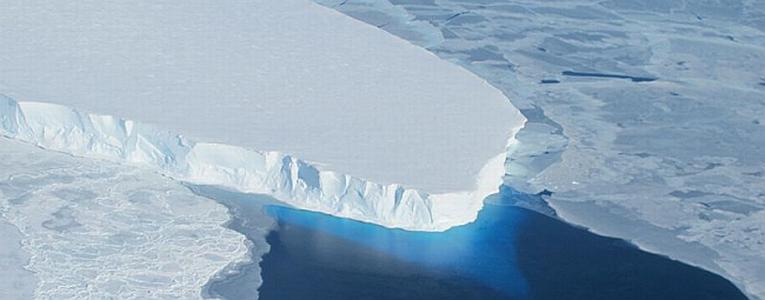
The calving front of Thwaites Ice Shelf in 2012. Photo by JamesYungel | NASA IceBridge.
The continued rapid melting of Antarctica’s Thwaites glacier is worrying, at the very least. The glacier was dubbed “The Doomsday Glacier” by an article in Rolling Stone magazine in 2017. At 80 miles across, Thwaites is the widest glacier in the world—roughly the size of Florida. Every year, it loses 50 billion tons of ice, contributing around 4 percent of annual global sea level rise. If the entire glacier were to melt, it would raise the ocean by 25 inches.
Last September, we saw a blizzard of scary headlines announcing that the doomsday glacier was “holding on by its fingernails,” inspired by a statement by the British Antarctic Survey’s Robert Larter, who said, “Thwaites is really holding on today by its fingernails, and we should expect to see big changes over small time scales in the future — even from one year to the next — once the glacier retreats beyond a shallow ridge in its bed.”
This month, new research by the British Antarctic Survey and the US Antarctic program concluded that Antarctic glaciers may be more sensitive to changes in sea temperature than was thought. The new research suggests that even low amounts of melting can potentially push a glacier further along the path toward eventual disappearance.
Adding to the concern, there is now less sea-ice surrounding the Antarctic continent than at any time since we began using satellites to measure it in the late 1970s.
Is it time to panic? Maybe not. In October, Stephanie Krzywonos, writing in the Sierra Club magazine, Sierra, argued that There Is No “Doomsday Glacier”. She writes:
Thwaites is melting, and at risk of melting a lot more. That “16 feet of sea level rise” projection is also accurate. What’s missing is the timescale. Scientists are concerned that only part of Thwaites—its Eastern Ice Shelf, the part of its body that floats above the ocean—will collapse within 10 years. It is true that the shelf’s collapse would set off a “chain reaction,” but according to the Cooperative Institute for Research in Environmental Sciences at the University of Colorado Boulder, that “2 to 10 feet” of sea level rise will require centuries to unfold,” possibly a millennium—we don’t know. The original Rolling Stone article acknowledged this uncertainty, well after the alarm of the first few paragraphs. “Ice is alive,” says Thwaites researcher Erin Pettit, near the end of the article. “It moves and flows and breaks in ways that are difficult to anticipate.”
This is not to say that we should carry on with business as usual because we have centuries to spare. But there is danger in prematurely affirming that we’ve passed the so-called point of no return. In a follow-up answer to a question on Twitter, Larter estimated that by 2100 the world might see about three feet of sea level rise “but with large uncertainties.” Partly this uncertainty is because there is still a lot to learn about ice sheet dynamics. But it’s also because how much sea level rise we see depends on how much we emit in the future.
She goes on to note that the people who study Thwaites are clear in their conclusions: The impacts of melting glaciers can still be mitigated depending on how humans respond in coming decades.
So, while it may not be time to panic, it appears that we must do what can be done to control climate change before we reach the “point of no return.”
Thanks to Alaric Bond and David Rye for contributing to this post.
